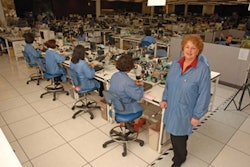
By Andrew K. Reese
At his dinner keynote address at the November 2009 annual meeting of the automotive industry's Original Equipment Suppliers Association (OESA), Dave McCurdy, president and CEO of The Alliance of Automobile Manufacturers, acknowledged the elephant in the room when he said, "The auto industry faces unprecedented economic challenges." McCurdy went on to note that industry sales had fallen from 16 million units in 2007 to about 10 million in 2009, a stunning contraction of nearly 40 percent.
Much of the speculation about the industry has focused on future consolidation in the supply base as weaker vendors get acquired or go out of business. That's understandable given that the OESA reported some 200 industry suppliers shutting down last year, along with 54 suppliers going into bankruptcy. However, beyond the immediate-term issue of surviving the Great Recession's tight credit and depressed demand, the automotive supply chain faces longer-term challenges in adopting the new technologies that hold the key to the industry's future, says Bill Michels, CEO at ADR North America and a leading expert on procurement and supply chain.
"We're seeing the industry trying to adopt new technologies, for example, for electric vehicles," Michels says. "But as we've seen the move to electric vehicles, that really requires a whole new set of technology suppliers and a whole new supply chain." Michels wonders out loud how many of the industry's traditional suppliers are going to be able to afford the investments necessary to transition to the new supply chain. "You wonder how long are the traditional metal-bending suppliers and casting suppliers and engine suppliers going to be around."
The reliance on innovative technologies also will drive a different power dynamic in the automotive supply chain, Michels says. He believes that the new suppliers who are going to be providing Detroit with the technologies that the OEMs need to survive are unlikely to knuckle under to the kinds of relationships that have been the standard in the domestic industry. "The new suppliers in the marketplace really have the leverage now, and the OEMs are going to have to learn how to partner with these suppliers in order to deliver new vehicles to the market," says Michels. He points to the example of the foreign OEMs like Toyota and Honda who famously rely on their suppliers for innovation and who have been proactive in partnering with suppliers around technology development.
In addition, Michels sees the domestic industry shifting away from the disaggregated supply chain. "It's going to have to be an integrated supply chain because all the technology has to work together, and all the planning has to work together, in order for them to be successful in their new ventures," he says. That shift will force procurement at the OEMs to adopt a much more collaborative approach to cost-modeling and information exchange across the supply chain. "The suppliers are really just an extension of manufacturing capability, and the OEMs have got to realize that, and they have to become more relationship-focused and more principled," Michels says.
This dynamic, in turn, will drive changes in the skill sets necessary within procurement organizations at the OEMs. "You're going to need technical people with commercial skills," Michels says. "The old-time buyer focused on using all your leverage to drive cost out has got to change to someone who is very technically oriented, very analytical and a relationship-builder. If you don't have those skills, you won't survive."
Michels suggests that Ford's planning over the past five years to prepare for the new dynamic, including coming out a couple years ago with a new supplier relationship management program, will work to the company's benefit now. But with Chrysler's survival still an open question, and with GM transitioning to new supply chain leadership with the departure of Bo Andersson as head of purchasing, Michels believes that the industry as a whole still is in the process of figuring out what the new automotive supply chain will look like. "I don't think that the industry has quite defined where it's going yet," he says, adding, "I think there's going to be more of what we saw in 2009 until they find their way." ¦
At his dinner keynote address at the November 2009 annual meeting of the automotive industry's Original Equipment Suppliers Association (OESA), Dave McCurdy, president and CEO of The Alliance of Automobile Manufacturers, acknowledged the elephant in the room when he said, "The auto industry faces unprecedented economic challenges." McCurdy went on to note that industry sales had fallen from 16 million units in 2007 to about 10 million in 2009, a stunning contraction of nearly 40 percent.
Much of the speculation about the industry has focused on future consolidation in the supply base as weaker vendors get acquired or go out of business. That's understandable given that the OESA reported some 200 industry suppliers shutting down last year, along with 54 suppliers going into bankruptcy. However, beyond the immediate-term issue of surviving the Great Recession's tight credit and depressed demand, the automotive supply chain faces longer-term challenges in adopting the new technologies that hold the key to the industry's future, says Bill Michels, CEO at ADR North America and a leading expert on procurement and supply chain.
"We're seeing the industry trying to adopt new technologies, for example, for electric vehicles," Michels says. "But as we've seen the move to electric vehicles, that really requires a whole new set of technology suppliers and a whole new supply chain." Michels wonders out loud how many of the industry's traditional suppliers are going to be able to afford the investments necessary to transition to the new supply chain. "You wonder how long are the traditional metal-bending suppliers and casting suppliers and engine suppliers going to be around."
The reliance on innovative technologies also will drive a different power dynamic in the automotive supply chain, Michels says. He believes that the new suppliers who are going to be providing Detroit with the technologies that the OEMs need to survive are unlikely to knuckle under to the kinds of relationships that have been the standard in the domestic industry. "The new suppliers in the marketplace really have the leverage now, and the OEMs are going to have to learn how to partner with these suppliers in order to deliver new vehicles to the market," says Michels. He points to the example of the foreign OEMs like Toyota and Honda who famously rely on their suppliers for innovation and who have been proactive in partnering with suppliers around technology development.
In addition, Michels sees the domestic industry shifting away from the disaggregated supply chain. "It's going to have to be an integrated supply chain because all the technology has to work together, and all the planning has to work together, in order for them to be successful in their new ventures," he says. That shift will force procurement at the OEMs to adopt a much more collaborative approach to cost-modeling and information exchange across the supply chain. "The suppliers are really just an extension of manufacturing capability, and the OEMs have got to realize that, and they have to become more relationship-focused and more principled," Michels says.
This dynamic, in turn, will drive changes in the skill sets necessary within procurement organizations at the OEMs. "You're going to need technical people with commercial skills," Michels says. "The old-time buyer focused on using all your leverage to drive cost out has got to change to someone who is very technically oriented, very analytical and a relationship-builder. If you don't have those skills, you won't survive."
Michels suggests that Ford's planning over the past five years to prepare for the new dynamic, including coming out a couple years ago with a new supplier relationship management program, will work to the company's benefit now. But with Chrysler's survival still an open question, and with GM transitioning to new supply chain leadership with the departure of Bo Andersson as head of purchasing, Michels believes that the industry as a whole still is in the process of figuring out what the new automotive supply chain will look like. "I don't think that the industry has quite defined where it's going yet," he says, adding, "I think there's going to be more of what we saw in 2009 until they find their way." ¦














![Pros To Know 2026 [color]](https://img.sdcexec.com/mindful/acbm/workspaces/default/uploads/2025/08/prostoknow-2026-color.mduFvhpgMk.png?ar=16%3A9&auto=format%2Ccompress&bg=fff&fill-color=fff&fit=fill&h=135&q=70&w=240)

